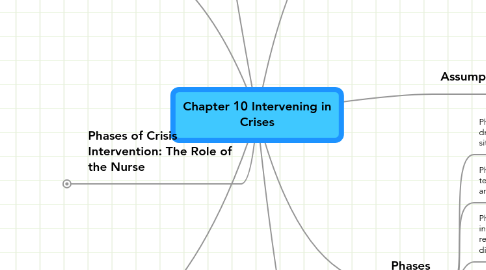
1. Crisis Intervention
1.1. The minimum therapeutic goal of crisis intervention is psychological resolution of the individual’s immediate crisis and restoration to at least the level of functioning that existed before the crisis period.
1.2. A maximum goal is improvement in functioning above the precrisis level.
2. Phases of Crisis Intervention: The Role of the Nurse
2.1. Assessment. Information is gathered regarding the precipitating stressor and the resulting crisis that prompted the individual to seek professional help.
2.2. Planning of Therapeutic Intervention. From the assessment data, the nurse selects appropriate nursing diagnoses that reflect the immediacy of the crisis situation. Desired outcome criteria are established. Appropriate nursing actions are selected taking into consideration the type of crisis, as well as the individual’s strengths and available resources for support.
2.3. Intervention. The actions identified in the planning phase are implemented. A reality-oriented approach is used. A rapid working relationship is established by showing unconditional acceptance, by active listening, and by attending to immediate needs. A problemsolving model becomes the basis for change.
2.4. Evaluation of Crisis Resolution and Anticipatory Planning. A reassessment is conducted to determine if the stated objectives were achieved. A plan of action is developed for the individual to deal with the stressor should it recur.
3. Crisis on the Inpatient Unit
3.1. Anger
3.1.1. A number of characteristics describe anger, including frowning, clenched fists, intense eye contact, yelling and shouting, lowpitched verbalizations forced through clenched teeth, and emotional overcontrol with flushing of face.
3.1.2. Anger is a stage of the grieving process.
3.1.3. Anger turned inward results in depression.
3.1.4. Some individuals need assistance to recognize their true feelings as anger.
3.2. Aggression
3.2.1. Aggression can arise from such feeling states as anger, anxiety, guilt, frustration, or suspiciousness.
3.2.2. Aggressive behaviors may be mild, moderate, severe, or extreme.
3.2.3. Aggression may be characterized by sarcasm, verbal or physical threats, degrading comments, throwing or striking objects or people, suicidal or homicidal ideation, disturbed thought process and perception, and anger disproportionate to the situation.
3.3. Assessing Risk Factors
3.3.1. Prevention is the key issue in the management of aggressive or violent behavior.
3.3.2. The violent individual usually feels underlying helplessness.
3.3.3. The most widely recognized risk factor for violence in a treatment setting is past history of violence.
3.3.4. Diagnoses that have the highest association with violent behavior include schizophrenia; organic brain disorders; mood disorders; antisocial, borderline, and intermittent explosive personality disorders; and substance use disorders.
3.3.5. The “prodromal syndrome” describes a set of behaviors that are predictive of impending violence. They include anxiety and tension, verbal abuse and profanity, and increasing hyperactivity.
3.4. Diagnosis/Outcome Identification
3.4.1. Dysfunctional grieving may be used when anger is expressed inappropriately and the etiology is related to a loss.
3.4.2. Ineffective coping
3.4.3. Risk for self-directed or other-directed violence
3.4.4. Outcomes evaluate success of the individual in maintaining anger at a manageable level and the prevention of harm to self or others.
4. Disasters
4.1. overwhelms local resources and threaten the function and safety of the community.
4.2. leaves victims with a damaged sense of safety and well-being and varying degrees of emotional trauma
4.3. Assessment
4.3.1. Grieving is a natural response.
4.3.2. Common behavioral responses include anger; disbelief; sadness; anxiety; fear; sleep disturbances; and increases in alcohol, caffeine, and tobacco use.
4.3.3. Children may experience separation anxiety, nightmares, and problems with concentrating.
5. Assumptions
5.1. 1. Crisis occurs in all individuals at one time or another and is not necessarily equated with psychopathology.
5.2. 2. Crises are precipitated by specific identifiable events.
5.3. 3. Crises are personal by nature.
5.4. 4. Crises are acute, not chronic, and will be resolved in one way or another within a brief period.
5.5. 5. A crisis situation contains the potential for psychological growth or deterioration.
6. Types
6.1. Dispositional crises are acute responses to external situational stressors.
6.2. Crises of anticipated life transitions occur with normal life-cycle transitions that may be anticipated but over which the individual may feel a lack of control.
6.3. Crises resulting from traumatic stress are those that are precipitated by an unexpected, external stressor over which the individual has little or no control and from which he or she feels emotionally overwhelmed and defeated.
6.4. Maturational or developmental crises occur in response to situations that trigger emotions related to unresolved conflicts in one’s life.
6.5. Crisis reflecting psychopathology is one in which preexisting psychopathology has been instrumental in precipitating the crisis or in which psychopathology significantly impairs or complicates adaptive resolution.
6.6. Psychiatric emergencies are crisis situations in which general functioning has been severely impaired and the individual rendered incompetent or unable to assume personal responsibility.
7. Definition
7.1. a sudden event in one’s life that disturbs homeostasis, during which usual coping mechanisms cannot resolve the problem.
8. Phases
8.1. Phase 1: The individual is exposed to a precipitating stressor. Major disorganization of the individual with drastic results often occurs. Whether or not an individual experiences a crisis in response to a stressful situation depends on:
8.2. Phase 2: When previous problem-solving techniques do not relieve the stressor, anxiety increases further.
8.3. Phase 3: All possible resources, both internal and external, are called on to resolve the problem and relieve the discomfort.
8.4. Phase 4: If resolution does not occur in previous phases, the tension mounts beyond a further threshold or its burden increases over time to a breaking point.
8.5. Major disorganization of the individual with drastic results often occurs. Whether or not an individual experiences a crisis in response to a stressful situation depends on:
8.5.1. The individual’s perception of the event
8.5.2. The availability of situational supports
8.5.3. The availability of adequate coping mechanisms
